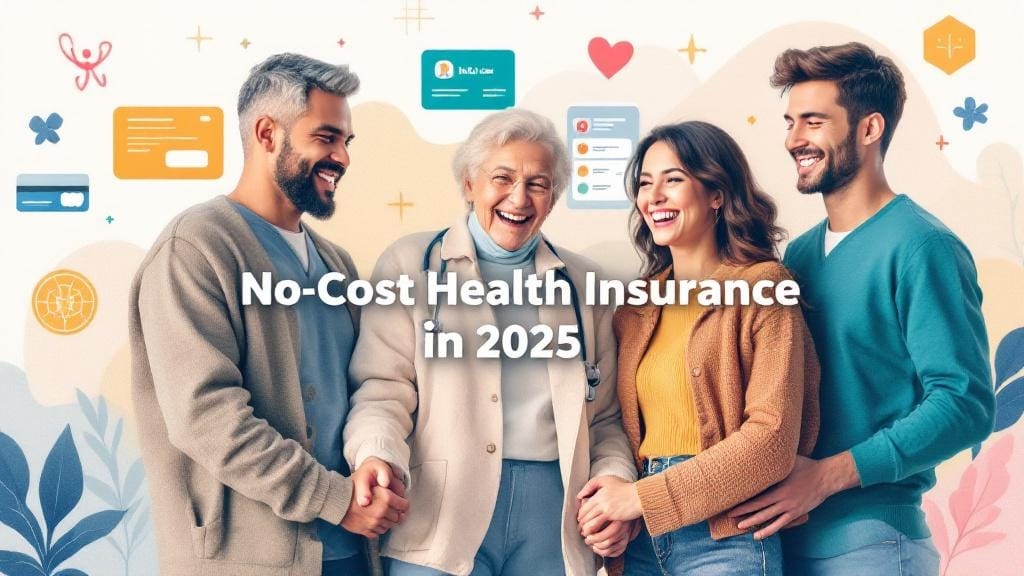In 2025, healthcare in the U.S. continues to be a concern for millions of people, especially when faced with the rising costs of medical care. While many believe that health insurance is only for those with significant income, there are options that allow individuals and families to get no-cost health insurance. Yes, you can access health insurance at no cost or minimal cost if you qualify for government programs, subsidies, or other health coverage options.
In this guide, we’ll walk you through the various ways to access no-cost health insurance in 2025, making healthcare more affordable for everyone—especially for low-income families, senior citizens, and individuals in need of medical coverage.
What is No-Cost Health Insurance?
No-cost health insurance refers to plans or programs that cover your medical expenses without requiring you to pay premiums. These programs often come from government agencies or nonprofit organizations that aim to provide affordable healthcare to individuals and families with limited financial resources.
Some of the most common no-cost options include Medicaid, Medicare, and various government-subsidized health plans that are designed to offer free health coverage or free medical insurance to eligible individuals. But how do you get access to these plans, and who qualifies for them?
1. Government-Sponsored Health Programs: Medicaid and Medicare
Medicaid: Health Insurance for Low-Income Families
One of the most well-known programs providing health insurance at no cost is Medicaid, a joint federal and state program that offers coverage to low-income individuals and families. Medicaid is designed to help those who cannot afford traditional health insurance plans. It covers a wide range of health services, including hospital visits, doctor’s visits, prescription drugs, and preventive care.
Eligibility for Medicaid largely depends on your income, household size, and state of residence. Since Medicaid is a state-managed program, each state has its own income limits and rules.
Here’s how you can qualify for Medicaid:
Income Level: You must fall under the federal poverty line or meet other state-specific requirements.
Household Size: Your eligibility may be influenced by the number of people in your household. Families with children or pregnant women are often prioritized.
Disability: If you have a disability, you might qualify for Medicaid even if your income is slightly above the general threshold.
Age: Pregnant women, children, and seniors are often given priority when applying for Medicaid.
To apply, visit the Medicaid website or your state’s Medicaid portal and fill out an application. The process may require you to submit proof of income, household size, and citizenship status.
Medicare: Free or Low-Cost Health Insurance for Seniors
Another key program is Medicare, a federal program primarily aimed at people aged 65 and older, and for some younger individuals with disabilities. While Medicare is generally not free, many beneficiaries qualify for zero-cost health insurance options within the program through Medicare Savings Programs.
Medicare covers a variety of health services, including hospital care, doctor visits, and some prescription drugs. If you are eligible for Medicare, you may also qualify for subsidies or additional benefits through programs like Medicare Extra Help, which can help reduce out-of-pocket costs for prescription drugs.
Medicare Savings Programs (MSPs)
If you’re eligible for Medicaid but still need help paying for Medicare premiums, you may qualify for a Medicare Savings Program that covers your premiums, deductibles, and co-payments, bringing your healthcare costs down to no premium health insurance levels.
2. Affordable Care Act (ACA) and the Marketplace
The Affordable Care Act (ACA): Health Insurance for Low-Income Families
The Affordable Care Act (ACA) established the Health Insurance Marketplace, a platform that allows individuals and families to shop for affordable health insurance options. The Marketplace offers subsidies and healthcare assistance programs based on your income level, and in some cases, you may qualify for free healthcare for families.
If you meet the income requirements, you may be eligible for subsidized health plans, with premiums that can be as low as $0 per month. These programs are designed to make healthcare affordable for families, especially those who are self-employed or have irregular income.
You can apply for these plans through the HealthCare.gov website, which serves as the portal for the Health Insurance Marketplace. Depending on your income, you might also qualify for cost-sharing reductions, which lower your out-of-pocket costs for medical services.
3. Subsidized Health Plans and Healthcare Assistance Programs
Subsidized Health Plans for Low-Income Families
For individuals and families who don’t qualify for Medicaid, but still need help paying for health insurance, subsidized health insurance through the Marketplace is an excellent option. These government-subsidized health plans are based on income, and the lower your income, the more subsidies you can receive.
Subsidies can significantly reduce your monthly premiums, making health insurance much more affordable, even for those who might not have thought they could afford it. In some cases, you may qualify for a free health insurance plan based on your household’s income and family size.
How to Apply:
Visit HealthCare.gov or your state’s health insurance marketplace.
Fill out an application with your financial details, including income and household size.
Review your options and select a plan that fits your needs and budget.
4. Free Health Insurance for Individuals
If you are a single person with a low income, you may be eligible for free health insurance for individuals through government programs or Medicaid. Many states also offer special coverage options for individuals who don’t have access to employer-sponsored insurance.
Some states have expanded Medicaid to cover more people, including childless adults and those with incomes above the federal poverty line. This means that even if you’re a single person or a student, you may qualify for health insurance at no cost.
5. Health Insurance for Senior Citizens: Zero-Cost Plans
In 2025, senior citizens can access various health insurance options with little to no cost. If you’re 65 or older, Medicare is your go-to program, and in some states, senior citizens can get extra assistance through Medicaid or Medicare Savings Programs.
These programs ensure that senior citizens don’t have to pay hefty premiums or out-of-pocket costs for necessary healthcare services, making free healthcare for seniors more accessible.
Frequently Asked Questions (FAQs)
1. What are the best options for no-cost health insurance in 2025?
The best options for no-cost health insurance include Medicaid, Medicare, and subsidized plans through the Affordable Care Act (ACA). These programs provide health coverage to low-income individuals, families, and senior citizens, depending on eligibility.
2. How do I qualify for Medicaid in 2025?
To qualify for Medicaid in 2025, you must meet income and other eligibility criteria that vary by state. In general, you need to have a low income, be pregnant, have a disability, or be over the age of 65.
3. What is the difference between Medicaid and Medicare?
Medicaid is for low-income individuals and families, regardless of age, while Medicare is for individuals over 65 or those with certain disabilities. Both programs can provide no premium health insurance depending on your circumstances.
4. Can I get free health insurance through the ACA?
Yes, if your income falls below a certain threshold, you may qualify for subsidized health insurance through the ACA marketplace, which can reduce your monthly premiums to zero.
5. Is there a health insurance program for families with children?
Yes, Medicaid and the Children’s Health Insurance Program (CHIP) provide free health coverage for families with children, particularly those with low or moderate incomes.
6. What are healthcare subsidies and who can get them?
Healthcare subsidies are financial aids provided by the government to lower your health insurance costs. You can qualify for these subsidies if your income is between 100% and 400% of the federal poverty level.
7. Are there free health insurance options for senior citizens?
Yes, senior citizens may qualify for Medicare and Medicaid, with many options for zero-cost health insurance through Medicare Savings Programs and Medicaid coverage.








Comments (0)